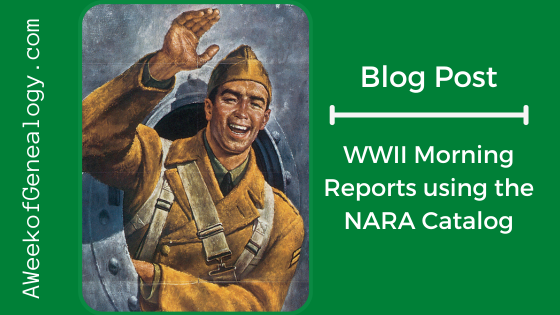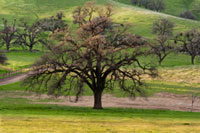WWII Morning Reports using the NARA Catalog

(Note: this blog post was updated to reflect the use of different browsers when viewing these records.)
WWII Morning Reports up to 1943 are now available on the NARA website and can be located through the NARA Catalog. (More Morning Reports are being added, as I have located ones for 1944, too.) For those wishing to research WWI Morning Reports, I recommend using them on Fold3.
Why search for the Morning Reports?
These organizational records can tell us where all the assigned soldiers were on a specific day, and the activities being done. They tell us when and how soldiers moved from place to place. They show when there were promotions, sick for duty and when they were sent to the hospital. They also show if soldiers were assigned to other organizations for temporary duty, or when they were permanently transferred to another organization. At a minimum, a soldier’s name will appear upon transferring in and transferring out of an organization. Memos may also be tucked into these reports.
For those of us whose Army ancestors’ personnel files burned in the fire in 1973, without leaving enough to be restored through technical means, these records are a key part of the reconstruction process.
Why search for them now?
In this blog post, I will describe how to search for the Morning Reports and download them. The process is not as easy as searching through fully indexed records, which will definitely come soon.
Given that fully indexed records will be easier to search, the question becomes whether or not to wait. For me, there have been some research questions that I have been wanting to answer, and these records hold many of those answers.
Know before you search
Currently Morning Reports up to 1943 (with at least some beyond that date) are available to view and download through the NARA Catalog. That means if the military organization was not formed until after the last year that was loaded to the catalog, you will not find the records. It also means that if your soldier joined an organization after the last year currently in the catalog, you will not see them in the records.
The WWII Morning Reports were filmed by month, then organization. That means you will have to hunt down the group of Morning Reports month-by-month.
As of the writing of this post, the numbering of the images in a set of reports may differ between browsers. The short takeaway is that the Firefox browser shows the images in reverse order, while the Chrome browser shows them in chronological order. For example, Image 992 of 1000 when viewed in the Firefox browser is the same image as Image 9 of 1000 when viewed in the Chrome browser. For more details and conversion see the note at the bottom of the post. (You might expect NARA to make changes in the future.) Just remember that you may have to follow the Prev or Next arrow for navigation through the Reports for the month.
For example, I was searching for Batteries within a Gun Battalion using the Firefox browser, so Btry D will appear before Btry A. When the download the files, you will see the number in the filename decreases.
There is a SPACER image separating reports between organizations, so look for them at the start and end of the month.
Searching for a name
This approach is not recommended. Searching the NARA Catalog can be awkward, and when I did try to search for a name the search results gave no feedback to help identify if a result would be of use to me. Searching these records by name will evolve over time, possibly on another existing genealogical website.
Searching by military organization
This blog post will focus on searching for the military organization for a soldier.
The website for NARA’s Morning Reports 1912-1946 can be found at: https://catalog.archives.gov/id/85713825

To begin your search, select the “Search within this Series” button, or go to https://catalog.archives.gov/search-within/85713825

The search box on the page contains the text “Search within this Series.” This box is where you type your search terms.

Searching option: I found it easier to search the whole catalog. Of course, the effectiveness of this technique will depend on the keywords that are used. You can try it both ways and see which way works better for you! I searched from: https://catalog.archives.gov

I scrolled through the results to scout out what was available.

Since I did not review the result for the Red Wings in 1999, I cannot be sure what how the search terms 500th and AAA connected with the record. Perhaps the result included words about a 500th game or goal, and AAA Hockey teams. Most results seemed more relevant to my goal of finding promising Morning Reports.
NOTE: YOU HAVE TO CLICK ON THE SEARCH RESULTS to see the links to the results within the set of images where the search terms are located. (You cannot open in new tab and to see the images with the search results (the organization)! If you were to click to open in a new tab, you would be taken to the first image on the roll, with no navigational clues to get to the morning reports of the organization.
I thought that September 1943 would be interesting, as it was the first full month that the 500th AAA Gun Battalion was stationed in Greenland.

Clicking on this result takes you to the first image on the roll, which is most likely NOT what you are looking for. See the list of links to the search results located on the right.

Since we know that these rolls were filmed backwards, we know that Image 249 is the last image of the Battalion for September 1943. Click on the link: Image # 249.

Image #249 is the last page of September Morning Reports for all of the 500th AAA Bn CAC. It is the last page of the Medical Detachment’s September Morning Reports (Med Det 500th AAA Bn CAC), which is the report for 30 September 1943. Below is a close up of the top of the report.

Keep looking at the Organization field to get to the battery, company or other organization you are seeking.
From the page with the image, you can view and download the image to your computer. The Download button is on the lower left of the document viewing window.

You can also click on Extracted Text to open a window with text that has been extracted from the image, and can be copied. Although a few errors may be present, the quality of recognizing the typewritten characters is good.

I left the Extracted Text window open as I viewed image by image, going backward in the days of September 1943 so that I could collect the text. (I am keeping an Excel Spreadsheet with the image numbers, links and other data.)
At the bottom of the image viewing window, I used the Next button to see the previous Morning Report.

Since I went through the images sequentially, they began with the end of the Medical Detachment and ended with the beginning of the Headquarters and Headquarters Battery. The very last image was the beginning (because they were filmed backward), rewarding me with confirmation of what I knew about the 500th AAA [Gun] Bn parent and its sub units:

VARIATIONS ON SEARCH TERMS:
I did try a variety of search terms, experimenting with spelling out words, using more of the organization’s name, and the specific battery. Some of the results were for other battalions numbered in the 500’s (e.g. 502, 506). Definitely try different combinations of names and abbreviations when searching for military organizations.

What’s next for me
Downloading more of the 500th AAA Gun Battalion’s Morning Reports, searching both backward and forward to learn of their reorganizations. Of course, I will search for when my Father transferred in and out of the organizations to follow his history throughout his time in service.
I will also be trying to see if it might be more straightforward to search for the organization’s Morning Reports other ways.
Let me know how you do.

NOTE: This is a more detailed explanation. For now, when using the Firefox browser, navigation shows the images beginning at 1 displaying the last image of the set, and as the numbers increase the reports go back in time. When navigation through the images using a Chrome browser, image 1 is the beginning of the set of images. To locate the same image across browsers, you would need to reverse the numbering using the total image count.
If you find you need to convert the number of an image viewed in the Firefox browser to the locate the same image in a Chrome browser, you use the total number of images in the set (which is image number found after “of” between the Prev and Next arrows in the image navigation bar), and calculate the image numbers as follows:
Chrome Image # = total number of images in the set – Firefox Image # + 1
Firefox Image # = total number of images in the set – Chrome Image # + 1































